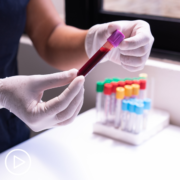What AML Patients Should Understand About Test Results
What AML Patients Should Understand About Test Results from Patient Empowerment Network on Vimeo.
What should patients with AML understand about test results? Dr. Gail Roboz emphasizes collaboration with the healthcare team to interpret test results and shares pertinent questions to ask during the discussion.
Related Resources:

|

|

|
Transcript:
Katherine Banwell:
I would like to get to an audience question that we received prior to the program. This one comes from Johanna. “How can I better understand my lab test results? What questions should I be asking my provider about those results?”
Dr. Gail Roboz:
One of the things that I would say to patients is to be careful when interpreting your own results, because I really am not exaggerating to say that patients have had absolute trauma looking at things that I look at it and say, “Oh, this looks great.” So, the first thing is, be careful being your own doctor.
The second thing though is that the author of the question has to understand that there’s going to be a tsunami of data coming in with respect to AML treatment. Sometimes in the hospital on a daily basis when you’re in the middle of an induction, there is a true – tsunami is the right word – a deluge of data, and you have to work with your team to say, “What am I following here? What’s important at this phase in my treatment?
What’s the number I’m looking at?” Patients sometimes tell me, “I don’t want to know any of this,” and I’m fine with that.
I think it’s actually okay. Sometimes patients will say, “Give me guidance,” and I will be specific. Because you can actually have a leukemia induction patient where every single laboratory value is abnormal. They might be getting pushed to a device, in the morning, sitting in the hospital on your iPad, 50 abnormal results. You’re trying to battle back the disease and be positive and advocate for yourself, but there are 50 abnormal results in front of you.
I think you have to really work with the team to say, “What am I looking at today? What are the numbers that are the really important ones? There are 50 abnormal ones here; everything is getting a yellow or a red light in this. How do I go through this?”
And to appreciate, also, that at different points in the treatment, the beginning of treatment induction post-remission therapy, you’re looking for different things. So, work with your team so that you’re not assessing every single result with equivalent weight, because I think you’re going to stress yourself out.










